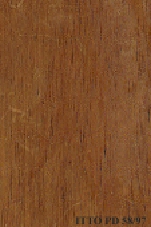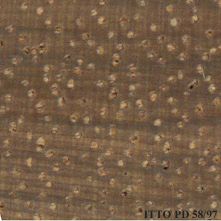
AGLAIA (Aglaia spectabilis)
Nome comercial
Aglaia
Nome científico (autor)
Aglaia spectabilis (Miq.) Jain & Bennet
Família
MELIACEAE
Nomes comuns
Goji nui (Vietnam); Surian batu (Malaysia); Lantupak (Sabah); Nuk kuk (Laos); Mokken (West Irian); Bekak (Malaysia); Goji nep (Vietnam); Tasua bailek (Thailand); Mokken (Indonesia)
Nome científico sinônimo (autor
Amoora ridleyi King; Amoora gigantea Pierre; Aglaia ridleyi (King) Pannell; Aglaia gigantea (Pierre) Pellegrin
DESCRIÇÃO DA ÁRVORE
Descrição botânica
It is a medium-sized to fairly large tree up to 40 m tall. The bole is branchless for up to 18 m and up to 150 cm in diameter. The buttresses are up to 4 m high.
Habitat natural
It is reported in primary and secondary rain forests, from the sea level up to 700 m of altitude.
IDENTIFICAÇÃO DA MADEIRA
Descrição anatômica da madeira (macro e micro)
Wood diffuse porous. Colored deposits in heartwood vessels. Tangential diameter of vessel lumina 100 to 200 micras. Vessel-ray pits similar to intervessel pits in size and shape. Simple perforation plates. Intervessel pits small, 7 micras or less. Paratracheal axial parenchyma scanty and/or vasicentric. Axial parenchyma bands more than 3 cells wide. Ray width 1 to 3 cells. Body ray cells procumbent with one row of upright and/or square marginal cells (Kribs-III). Septate fibers present.
-
 Foto de madeira macroscópica (tangencial)
Foto de madeira macroscópica (tangencial)
-
 Foto da secção transversal microscopica
Foto da secção transversal microscopica
DISPONIBILIDADE
Situação CITES sobre a proteção
Unrestricted
DESCRIÇÃO GERAL DA MADEIRA
Odor ou Cheiro
The wood often has a fragrant, sometimes even pungent, odor when fresh, resembling both cedar and camphor.
Cor
The heartwood is pale red to dark reddish-brown, sometimes turning to walnut-brown or chestnut-brown, usually distinctly demarcated from the pale yellow to pale red-brown sapwood.
Indice de cor
2
Grã
The grain is interlocked, sometimes straight.
Veios ou desenhos na superfície
The texture varies from moderately fine to moderately coarse.
DURABILIDADE NATURAL
The wood is rated as moderately durable even in contact with the ground.
Indice de durabilidade natural
3
Tratamento preservativo
The heartwood is often very difficult to treat with preservatives, the sapwood is moderately easy to easy.
PROPRIEDADES FÍSICAS DA MADEIRA
Densidade básica (Peso seco/Volume saturado) (g/cm³)
0.638679434
Densidade seca ao ar 12% (g/cm³)
0.71
Contração Tangencial Total (Saturado até peso seco) (%)
7.8
Contração Radial Total (Saturado até peso seco) (%)
5.0
Defeitos causados pela secagem
Ease of Drying: Drying is slow and rather difficult. Boards of 15 mm thick take about 3 months to air dry. Drying Defects: Resin exudation is reported to be common, especially when drying at high temperatures. It is prone to cupping, bowing, springing and end checking. Usually there is little splitting, surface checking, staining and insect attack during drying. Kiln Schedules: Schedule proposed for Apitong.
Programa de secagem recomendável
JP-26
Estabilidade dimensional (Contração Tangencial Total %/Contração Radial Total %)
1.5
Programa de secagem detalhado
http://www.tropicaltimber.info/wp-content/uploads/2015/09/KD_Japanese_ENG.pdf
PROPRIEDADES QUÍMICAS DA MADEIRA
PROPRIEDADES MECÂNICAS DA MADEIRA
Resistência a flexão a 12% (Módulo de ruptura) (kgf/cm²)
1004
Resistência a compressão paralela as fibras a 12% (kgf/cm²)
552
TRABALHABILIDADE
Serrar ou Cortar
Sawing of this species is easy.
Desdobro da tora em torno para lâminas
Veneer may warp severely during drying.
Desdobro da tora em faqueadeira para lâminas
Veneer may warp severely during drying.
Aspectos do processamento em máquinas
This species is easy to machine.
Aplainamento
Because of its grain it requires sharp and fine set planes, however, planed surfaces are smooth and lustrous.
Torneamento
30
Comportamento na aplicação de pregos
It is reported to have a good nailing behavior.
Colagem
This species is easy to glue.
Acabamento
Wood of this species is easy to finish.
USOS FINAIS RELATADOS
USOS FINAIS (RESUMO)
HOUSING GENERAL, boards, FURNITURE AND CABINETS, cabinets, PLYWOOD AND VENEER, TURNING, SPORTS, TOOLS, tool handles
CASAS
- 10 - Silica in Timbers
Tábuas
- 13 - Dry kiln schedules for commercial woods. Temperate and tropical. Section III. Latin American (Mexico, Central, and South America) Woods–Conventional Temperatures
MÓVEIS GABINETES
- 21 - Tropical timbers of the world. Part III-Southeast Asian and Oceanian Species.
Gabinetes
- 24 - Empire Timbers
CHAPAS
- 25 - Directory of Timber Trade Malaysia
Torneamento
- 30 - Embassy of Honduras in Japan
INSTRUMENTOS ESPORTIVOS
- 38 - Annual Review and Assessment of the World Timber Situation 1998-ITTO
FERRAMENTAS
- 42 - Utilización Industrial de Nuevas Especies Forestales en el Perú.
Mangos herramientas
- 43 - Maderas de Bolivia (Características y Usos de 55 Maderas Tropicales)
Please Provide Information To View Producer Information